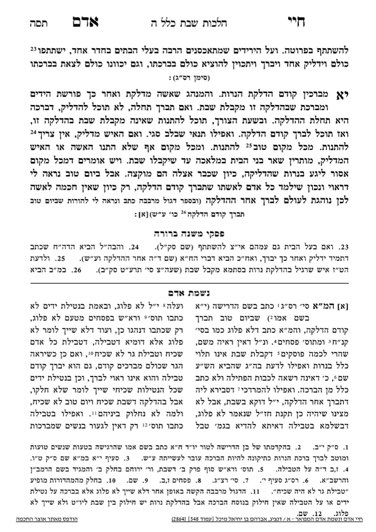We are beginning siman 11, where the Chayei Adam will discuss making the bracha. In general, we know that Chazal instituted that before one performs a mitzvah, they make a bracha. They instituted that the bracha should be made over le’asiyasan, that before the mitzvah is performed one should thank Hashem for the opportunity to perform it. The Gemara says that one exception is tevila and the rishonim explain that it includes netilas yadayim. The rishonim explain that it would look like an insult to the bracha if one made the bracha before washing, when a person’s hands are not yet clean. Other rishonim explain that the mitzvah of washing hands requires two stages, washing and drying, so as long as one makes the bracha before drying their hands, they have made the bracha over le’asiyasan.
There is also a halacha that one cannot create a hefsek between the bracha and the mitzvah. This is similar to making a bracha on food, where a person cannot make a hefsek between the bracha and eating the food.
The Noda B’Yehuda points out that this last point, of hefsek, also applies to netilas yadayim, so as soon as a person washes their hands, they cannot talk and must immediately make the bracha.
Regarding hadlakas neiros, the Shulchan Aruch writes that the woman should make the bracha and then light the neiros, like any other mitzvah. The Chayei Adam brings a minhag that a woman should light first and make the bracha after. This is the minhag of Ashkenazim, and some Sephardim as well. The Gemara only gives one exception, netilas yadayim, and possibly tevilah, but does not discuss hadlakas neiros as an exception. So we need to explain this minhag; why we do it this way, and how it works.
The reason for this minhag stems from the idea we learned that a woman accepts Shabbos through hadlakas neiros. This is the opinion of the BeHa”G, one of the Geonim and earliest seforim we have after the Gemara. There is discussion whether it is the bracha which effects the acceptance of Shabbos, or the lighting itself. If it is the bracha which effects the acceptance of Shabbos, if the woman would say the bracha first, she could no longer light, since she already accepted Shabbos. Therefore, out of concern for this possible understanding in the BeHa”G, the minhag has become for a woman to make the bracha after lighting.
We still need to understand how it is possible to make the bracha after a mitzvah, if the mitzvah has already been fulfilled. One explanation is that it is akin to netilas yadayim, that as long as there is no hefsek, it is considered over le’asiyasam. However, this explanation is not sufficient, as we do not have any other bracha in which Chazal established the procedure in this manner, which would lead us to conclude that this exception cannot be extended past netilas yadayim, where Chazal specifically enacted the procedure in a different way.
A possible explanation is that the mitzvah of neiros Shabbos is not the hadlakah, but the benefit from the light. That is the actual kavod shabbos, oneg shabbos, and shalom bayis. The hadlakah is along the lines of a hechsher mitzvah, preparation for the mitzvah, but the mitzvah itself is receiving the benefit of the lights. If so, as long as the woman has not benefited from the neiros before making the bracha, she can make the bracha after lighting, and it is over le’asiyasan to receive benefit from the lights.
One must remember that a home which was dark, before electricity, before lighting the neiros, it was close to dark at this time of day, and the neiros provided significant illumination. It is understandable how covering one’s eyes would therefore make the bracha over le’asiyasan. The woman would immediately cover her face after lighting, so that the benefit does not come until after making the bracha.
Summary
A woman lights the neiros, immediately covers her eyes, and then makes the bracha, out of concern that if she were to make the bracha beforehand, she would have already accepted Shabbos. She covers her eyes in order not to benefit from the light until after making the bracha, so that the bracha will be over le’asiyasan to receiving benefit from the neiros.



